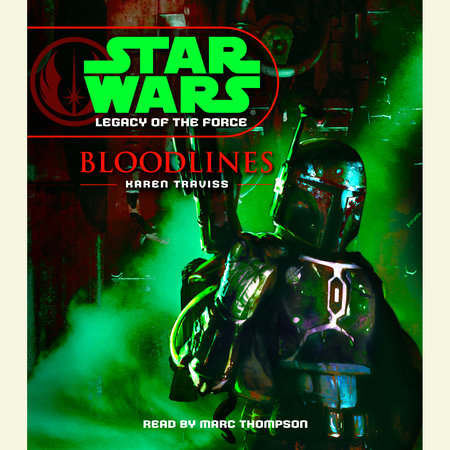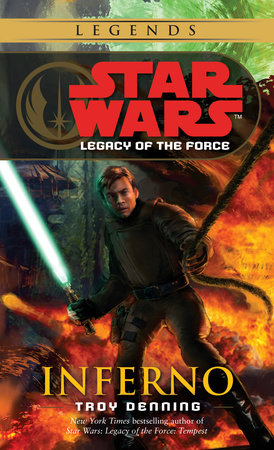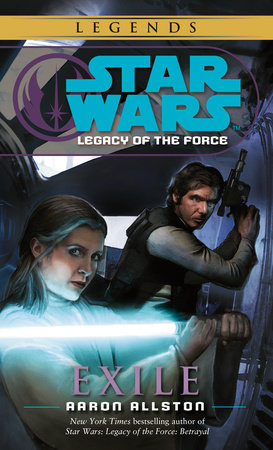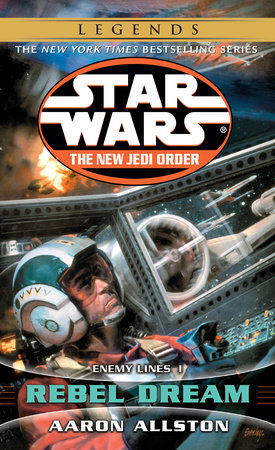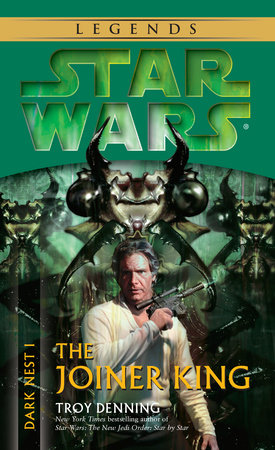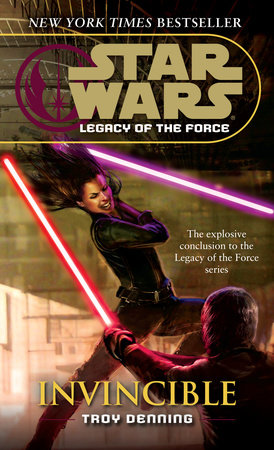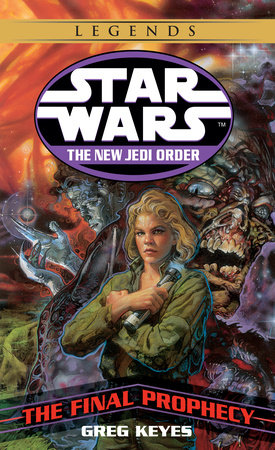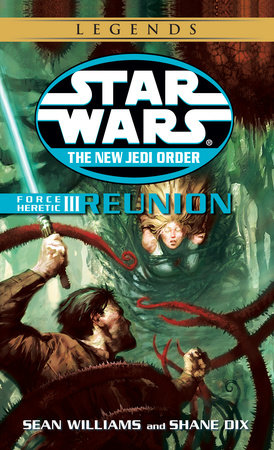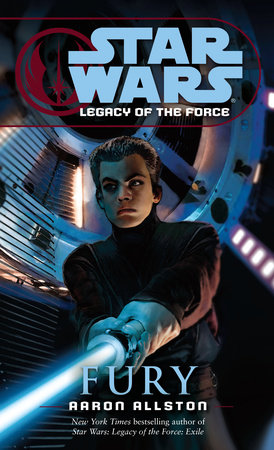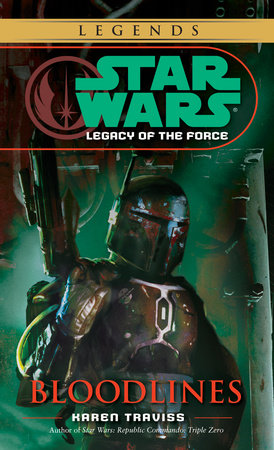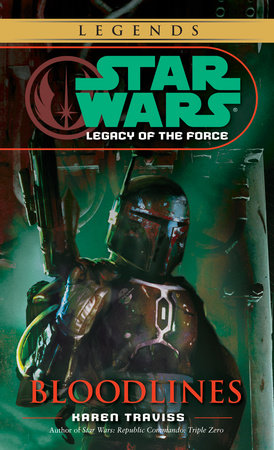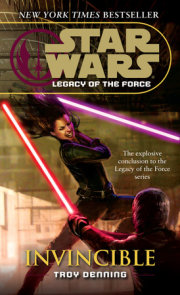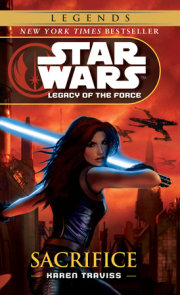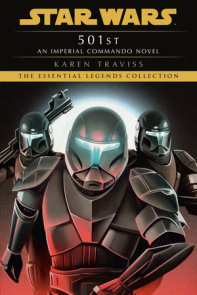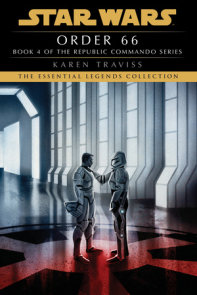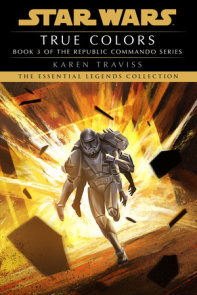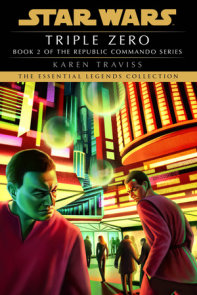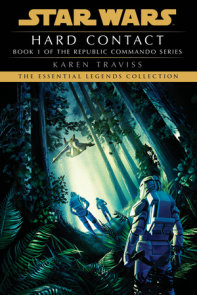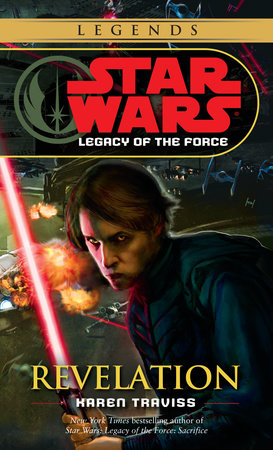Author Q&A
Interview with Karen Traviss author of Star Wars: Legacy of the Force: Bloodlines
Question: Bloodlines is the second novel in the Legacy of the Force storyline, a nine-book arc that picks up several years after the defeat of the Yuuzhan Vong. The Yuuzhan Vong were an external threat, from outside the galaxy. This time the threat to the Jedi and the Republic comes from within, both literally and figuratively, with a rebellion centered at Corellia that threatens civil war not only across the Republic but in the Solo and Skywalker clans, and Jacen’s disturbing embrace of the dark side. Did you and the other writers, Aaron Allston and Troy Denning, work out the plot of this arc together? What considerations led you to make the choices you made, and what degree of input and control was there from the folks at LucasBooks?
Karen Traviss: It’s a classic team effort. We sat in a meeting room at the Lucasfilm offices at Big Rock Ranch in California for a day–I flew out from the UK specially for the meeting–and we didn’t finish until we had a complete story arc that covered nine books. Much tea and choc chip muffins were consumed, I can tell you. The whole gang brainstormed–LFL Licensing people, Del Rey, and authors–and kicked ideas around: then it all went on a whiteboard and we sliced it nine ways. And I begged LFL to let me bring back Boba, so I was utterly delighted when they said yes.
It’s the opposite end of the spectrum from the way I tackled the Republic Commando novels, which were virgin territory, and I was the only one writing them. I like that variety in my working day. I really enjoy kicking stuff around with other creatives, and everyone now knows I’m a retcon addict. Retcon is retroactive continuity–the science of making stuff fit and getting better stories out of it. Retconning isn’t about changing existing continuity: it’s about taking seemingly contradictory issues that coexist in continuity already, due to errors or oversights, or even gaps, and finding a way to make it all work together, so that no piece of the continuity is ignored. Forget Sudoku and Rubik’s cubes–retcon is my Olympic mental gymnastics of choice.
Q: At the end of the previous novel, Betrayal, Jacen Solo has just killed a fellow Jedi in cold blood and embarked on the path to becoming a Sith master under the tutelage of Lumiya, an old adversary from Luke’s past. I’m sure I’m not the only reader who wants to slap some sense into him! Yet it must be a fascinating challenge for you to attempt a sympathetic portrayal of a Jedi’s corruption, especially with Jacen believing that he is only doing what is necessary to bring peace and order to the galaxy.
KT:I don’t aim for sympathetic or unsympathetic, actually: I aim for real, and even with a character that isn’t built by me–when I create characters, I build them from the ground up with a psych profile–I let them do the living and the talking. How does a clever, morally aware man go down the path that Jacen does? By self-delusion and self- justification. Jacen already has a high opinion of his powers and judgment, and that’s not misplaced: the man is good at his work. But he just disconnects from the outside world once too often and starts to see himself as having this mission to save the galaxy, and only he can do it…you watch the drift from good intentions to what he sees as necessary evils to all-out self-justification. Sadly, in my previous careers–as a journalist and later a spin doc working with politicians–I saw that very human pattern of behavior time after time after time. And I can watch it now in politicians in my own UK government: I won’t get too political here, but the capacity of those with power to make themselves believe in their own purity of purpose even when it’s obvious to those around them that they’re going bad and beyond bad is staggering to behold. They really do shift into a parallel world that only they can see, and shut out all dissent as they focus on what they want it believe and hear. Some of them start out corrupt and opportunistic, and some get sucked into it.
Getting into Jacen Solo’s head was one of the most unpleasant experiences I’ve ever had. When I write, it’s very tight third person POV–there’s no narrator. It’s all the characters’ own voices, seeing the world as they see it with no real help from me, and I just report what they see. Letting go in order to do that is very much like method acting, actors have told me. You become that character for the time being. And boy, was it scary being Jacen. It all seems utterly logical and inevitable to him–and, like all people who do terrible things, he has no sense of his own evil.
A wise friend described the slide into a personal delusional hell like Jacen’s as stemming from a deep-down belief that you’re the focus of the universe about which everyone else’s destiny pivots. And, of course, that’s exactly what Jacen thinks: only he can save the galaxy.
I was so freaked by being in his head that when I switched point-of-view characters, I wanted to launder my brain. It was so easy a trap to slip into. Anyone could do it in the right circumstances. That’s what makes evil–if we can use that value-laden word–so dangerous. It’s not rare, handed only to demons; it’s lurking in all of us, and it’s pretty banal.
Q: You’re no stranger to the Star Wars universe. How did you begin writing Star Wars books?
KT: Well, I am a stranger, really. I’m a total newbie. I’ve only been in print for just over two years (March 2004, when my first novel, City of Pearl, came out), and Bloodlines is my third Star Wars novel. I’ve just written a lot in a very short time.
I was asked if I wanted to write Star Wars completely out of the blue in late 2003. I didn’t even know what a tie-in entailed, in fact. Del Rey and Lucasfilm had seen advance copies of my book–City of Pearl wasn’t even published when they approached me–and said they thought I’d fit in okay. Then I got the call in late February 2004 to do the first Republic Commando novel.
I knew absolutely nothing about the universe, too, although I’d seen the movies, and I think coming to it stone cold gave me a different take on it. I had no preconceived notions, and I wasn’t raised on it. I fell in love with Star Wars’ complexity and its gray areas, which are perfect for a writer like me. I’m a journalist by background, so I take a neutral stance and just report what I see: I hate guiding readers and telling them what to think and who to like and dislike. I just want to show them what’s there and let them make up their own minds, which is something Star Wars enables very easily.
Q: You seem to have a special affinity for the character of Boba Fett.
KT:He’s a gift if you love writing flawed characters. I don’t write heroes or villains–I can’t see people that clearly differentiated–and Boba has so many flaws woven in with his brilliance that I could unpick his psychological profile for weeks and still not get bored.
The man is both a mess and an inspiration. He’s had the childhood from hell. No mother figure, and don’t tell me Taun We is any substitute: a cloistered existence: a father who, frankly, has a lot of strange emotional baggage himself: and then he sees Dad, the center of his life and his sole focus, killed in front of him. Paging Dr. Freud, Dr. Freud please pick up…and yet he still wins. He doesn’t just survive, he excels. He’s seen as a villain, but he has an unshakeable sense of honor and a rigid moral code. And he’s defined wholly by one thing: his relationship with his father, cut short before its time. Even his desire to excel as a bounty hunter is, I’m convinced, a legacy of his need to please his father and live up to his expectations.
So that makes a 70-plus-year-old Boba a fascinating character to write. He worships Jango as the perfect example of fatherhood, and yet he’s abandoned his own wife and child–because no human with his upbringing could ever really relate well to others, especially women. He’s made a fortune (more than once) but has no real use for it. He’s used to being the best in the galaxy at a very physical profession, but mortality and age are creeping up on him. How does he handle that? How does he come to terms with the legacy he’ll leave behind, such as it is?
The secondary fascination is how he handles the role of Mandalore. I’ve done a lot of work on Mandalorians, and even developed the culture and a working language for LFL, and the variety of styles of leadership over the centuries is striking. But Boba doesn’t speak Mandalorian (I stuck with the literal continuity there), and he’s still a working bounty hunter while in office, so to speak. That tells you not only a great deal about him, but also about the Mandalorians themselves.
It’s a fiction goldmine for me. I never tire of Boba or the Mandalorians.
Q: You mentioned City of Pearl, the first novel in your acclaimed Wess’har Wars series. Those books offer a hard sf look at the complications of first contact distinguished by complex world building and an unsentimental focus on the evolving–in more ways than one!–relationship between a human female, Shan Frankland, and an alien male, Aras. Some critics have complained that your view of humanity in this series is misanthropic . . . which seems like a parochial criticism for a reader of science fiction to make! But it’s true that humanity does not exactly distinguish itself by its collective actions in these books.
KT: I don’t think either point is accurate, actually. Reviews–professional reviews–haven’t complained about the portrayal of humanity in the series at all; quite the opposite, in fact. I think you mean a couple of Amazon reviews, which isn’t quite the same thing. I just describe the kind of human that I saw every working day for decades, and if it isn’t pretty, that’s the reader’s interpretation of it. Just as many readers have found a message of hope and human decency in the books. And the series isn’t focused on Shan and Aras–there are six books in the story arc and a big cast, and they get equal air time.
But it’s all unsentimental, I’ll give you that. Like I said, I just build the characters from scratch, put them in the scenario, and let the model run. The interaction between the characters is the plot. That’s all there is to it, really. The behavior of individuals and organizations is the way real ones behave: no heroes, and no villains, just people who are mixed bags of good and bad elements. The alien races are treated exactly the same way. But if you’ve been raised on the kind of SF where humans are top dog, and the aliens are always evil invaders, then my books are going to disturb that certainty. But I do that in Star Wars, too. Because I wasn’t steeped in the Star Wars culture to begin with, I found pretty bad things in the Jedi and some good in Vader, which comes from the journalistic approach I take. I don’t know how to do anything else beyond asking awkward questions, I suppose. All my stuff is about the politics of identity at some level, and the lines we draw–the point beyond which we abandon decency, and how we handle the moral dilemmas that our science and technology create for us..
Q: Do you finish writing a tie-in before embarking on the next original book, or do you prefer to have multiple projects going at the same time?
KT: I split my time pretty well equally between tie-ins and my own-copyright books. The schedules mean I don’t usually have an unbroken run at a book–sometimes I’ll have to stop mid-manuscript and switch to another book because I need to do revisions and copyedits. But I can handle switching between books and even to short fiction and related features like the work I do for Star Wars Insider. I can either partition my mental hard drive and switch the other work off completely in my head, or let it stay in my conscious brain: with the latter, I find that sparks all kinds of useful ideas for the other work. The more you write, the more you write…sounds crazy, but once the creative juices kick off, they keep the process going. You know what they say: if you want something done, ask a busy person. It’s about momentum.
Q: One of the fascinating things about the Legacy series so far is how it reveals the fault lines that have always existed in the relationships of the Solo and Skywalker families: between husbands and wives, brothers and sisters, parents and children. That’s certainly at the heart of Bloodlines.
KT: I’m not sure the fault lines are the issue, actually. But what’s great in one part of your life can turn out to be exactly the same thing that isn’t so great later. Real people don’t change that much at a fundamental level–although we show growth and epiphany in character arcs, of course, because that’s the nature of fiction–but the circumstances shift and what was your saving grace in your youth can make you a liability in your middle years and older. Take Han–his stubborn independence was terrific when the Empire needed overthrowing, but decades later, when the Solos and Skywalkers are part of the ruling elite themselves, the power brokers, he’s a problem for Luke. Whatever happened to the farm boy and the space bum? They grew up, and the galaxy changed.
Bloodlines is more about the pain that families can cause you, and how you can’t ever walk away from family completely. Only people you love and trust can hurt you, and most of the characters find that out in spades.
Q: I understand that you and your fellow writers are working in sequence on the series: first Allston, then you, then Denning, and so on. How closely do you three keep in touch? And are you already writing book five?
KT: Yes, it’s a juggling act. We stay in touch by e-mail, but the real anchors are the editors, Shelly Shapiro at Del Rey and Sue Rostoni at Lucasfilm. Readers might think that it’s a simple sequential thing–that each author reads what the previous one has written and picks up from it–but it can’t work that way at all. We’ve all got different work commitments, and we all write a different speeds. I’m naturally a very fast, immersive writer–four or five weeks per book now I’m writing full time, and that’s for all my novels, not just Star Wars–and I already have contractual commitments to other publishers built around the Legacy schedule that mean I can’t wait for someone to finish their book before I deliver mine. I have to turn it in on the due date and get on with the next book. That’s where the real discipline of writing as a team comes in: you stick to the outline you agreed with Lucasfilm and Del Rey, and you let everyone know if you need to change stuff. No surprises. Of course, that can’t possibly cover every single line in a book, so the editors are there playing long stop and fielding detail that might get missed. The creases get ironed out on revisions. The key to it is communicating throughout the process.
Q: What other projects are you working on now?
KT: I’m finishing the fifth book in my Wess’har series for HarperCollins, and then I’ll be going back to Sacrifice, LOTF #5. At the moment my schedule means I’ll probably switch to another series after that–can’t mention that one yet–and then I’ll go back to book six of the Wess’har arc, which is the final book in that six-part story. Then it’s back to Legacy again. That takes me to March 1, 2007, but somehow in that period I also have to fit in short fiction and what I’ll just call Other Projects at this stage…
If I had three wishes, they’d all be: "Get more sleep."
